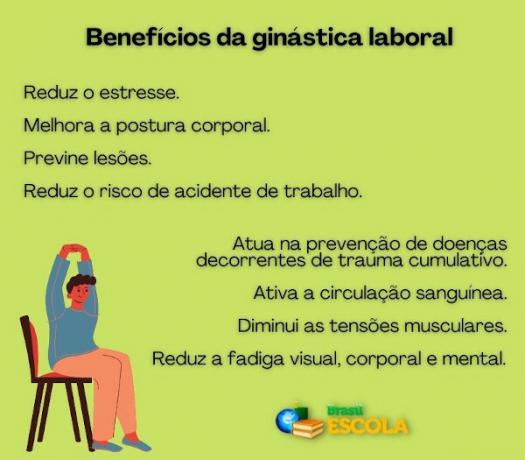Fitness labor is the corporal practice carried out in the work environment in favor of the well-being of workers. Among the objectives of labor gymnastics are the prevention of accidents at work, the fight against occupational diseases, such as anxiety and the stress, and increasing the functional capabilities of employees.
There are types of labor gymnastics: preventive, preparatory, corrective and relaxation. The exercises guided during this practice must be supervised by a professional of Physical education.
The reduction of body pain resulting from bad posture, the improvement of the quality of life at work and the relief of accumulated stress are some of the benefits provided by the practice of gymnastics labor.
Read too: Water aerobics — a bodily activity performed in an aquatic environment
Topics of this article
- 1 - Summary about labor gymnastics
-
2 - Types of labor gymnastics
- → Preparatory labor gymnastics
- → Compensatory labor gymnastics
- → Labor relaxation gymnastics
- → Corrective labor gymnastics
- 3 - Benefits of labor gymnastics
- 4 - Labor gymnastics exercises
- 5 - History of labor gymnastics
Summary about labor gymnastics
Labor gymnastics is divided into: preparatory, compensatory, relaxation and corrective.
Occupational gymnastics contributes to a better quality of life for workers, acting in the prevention of accidents at work.
The main exercise performed in labor gymnastics is stretching. Among the types of stretching are: dynamic, static and passive.
The emergence of labor gymnastics is associated with pause gymnastics, a practice performed during rest periods by European workers.
Rádio Taissô or radio gymnastics was regulated in 1928 and began to be applied in companies and schools.
In 1969, the Morning Gym program was one of the pioneering initiatives of corporal practices applied to workers in Brazil.
Do not stop now... There's more after the publicity ;)
Types of labor gymnastics
There are some types of labor gymnastics, and some of them are defined according to the moment in which the practice is carried out — whether before, during or after the working day. Understand better below.
→ Preparatory labor gymnastics
Preparatory labor gymnastics is performed before working hours or in the early hours. The intention is to provoke a bodily preparation of the large muscles of the collaborators that will be used throughout the work tasks.
The duration of this type of exercise is 15 minutes on average.. The actions carried out in the preparatory labor gymnastics provide better blood circulation, as well as improved muscle oxygenation. These effects are essential for a more quality workday.
→ Compensatory labor gymnastics
Compensatory labor gymnastics is done during working hours and can be performed in 10 The 20 minutes. The objective is precisely to pause work activities in order to compensate, through specific exercises, repetitive efforts and inadequate posture.
→ Relaxation labor gymnastics
Workplace relaxation gymnastics happens after hours and it can last from 15 to 20 minutes. The intention is to stretch the muscles and cause a relief of stress accumulated in the body. The exercises are essentially based on stretching and avoid the accumulation of lactic acid, preventing possible injuries.
→ corrective labor gymnastics
Corrective labor gymnastics is used to reduce the negative effects caused by work activities. Its practice must be adjusted according to the reality of the work environment, that is, observing what actions workers perform.
For example, a person who often lifts and carries weights off the floor. This worker recruits the musculature of the biceps brachii to support the objects that are carried and needs a musculature that involves the spine (as is the case with the quadratus lumborum) strengthened.
In this way, corrective labor gymnastics exercises will be prescribed and guided following these actions. The intention, in this case, is to strengthen the muscles involved in these movements. The activities of the practice will also act in correcting the bad posture that is acquired through work.
Know more: Bthe posture — an aspect essential for a good quality of life
Benefits of gymnastics
Check below what are the benefits of labor gymnastics:

In addition to the benefits of the practice, there are also benefits provided to companies who apply body gymnastics programs:
opportunity for greater integration among team members;
increased productivity;
reduction in the number of employee absences;
decrease in accidents at work.
Workplace gym exercises

In labor gymnastics, the following exercises can be performed:
Passive stretching: it is performed with the help of another person, who will apply a certain force to increase the range of movement of the person who is stretching. It is essential to make smooth movements, without speed, as well as to respect the limits of each one. The process of inhaling and exhaling is fundamental in this and any type of stretching.
Active or dynamic stretching: it is performed by the person who is stretching. Practice consists of the greatest amplitude achieved in movements that allow muscle stretching. Smoothness and rhythm are needed in both moving and breathing.
Static stretching: stretching position of a certain muscle group until the perception of the maximum resistance achieved. It is important to maintain good posture while performing.

See too: Trampoline gymnastics — a type of sports gymnastics
History of labor gymnastics
The origin of labor gymnastics is associated with pause gymnastics, term used by the industry in the moments of rest of the European workers. The first time that pause gymnastics was registered was in a manual edited in 1925, in Poland.
In 1928, in Japan, the practice of Rádio Taissô was regulated, which means radio gymnastics. The activity was initially applied in companies and schools and is currently broadcast on the official Japanese radio station. These are standardized exercise commands and guidelines that mobilize thousands of Japanese people to exercise in the morning.
The consolidation of labor gymnastics in Japan occurred in the 1960s, with mandatory compensatory practices aimed at preventing accidents at work and increasing productivity.
You U.S began to use labor gymnastics in 1968, since the creation of International Management Review. The initiative has become one of the most important assessments of workers' health.
At the Brazil, a program entitled Gymnastics Morning began to be carried out by the technical team of the Ishibrás Foundation in 1969. Inspired by Swedish and French methods, this activity was applied to 2,500 workers before their workday. The objective was to enable greater disposition and better physical improvement of the workers.
In 1978, the first Associação de Rádio Taissô was created in Brazil.. As a result, companies of Japanese origin that were installed in the country adopted the methodology among their employees.
From the 1990s, labor gymnastics as it is popularly known began to spread across the country.. The period was marked by the hiring of Physical Education professionals to carry out this type of activity.
The Brazilian Association of Labor Gymnastics (ABGL) was created in 2007, with the aim of fostering debate on health promotion in the workplace.
image credit
[1] Joa Souza / Shutterstock
By Lucas Afonso
journalist andphysical education professional
Would you like to reference this text in a school or academic work? Look:
AFONSO, Luke. "Labor gymnastics"; Brazil School. Available in: https://brasilescola.uol.com.br/educacao-fisica/ginastica-laboral.htm. Accessed on July 22, 2023.
Understand what stress is and learn about the stressor agents responsible for triggering this body response.
Click here, find out what gymnastics is, discover its types and find out about its history in Brazil and in the world.
Presentation of Artistic Gymnastics that for a long time was known as Olympic Gymnastics.
Physical activity in an aquatic environment that reduces the impact on joints and promotes well-being.
Click here and understand what bodybuilding is, what are its advantages and what it is capable of promoting.
Cringe
The slang adapted from English is used to designate someone who is seen as tacky, shameful, outdated and out of fashion.
Neurodiversity
A term coined by Judy Singer, it is used to describe the wide variety of ways the human mind behaves.
PL of Fake News
Also known as PL2660, it is a bill that establishes mechanisms for the regulation of social networks in Brazil.

